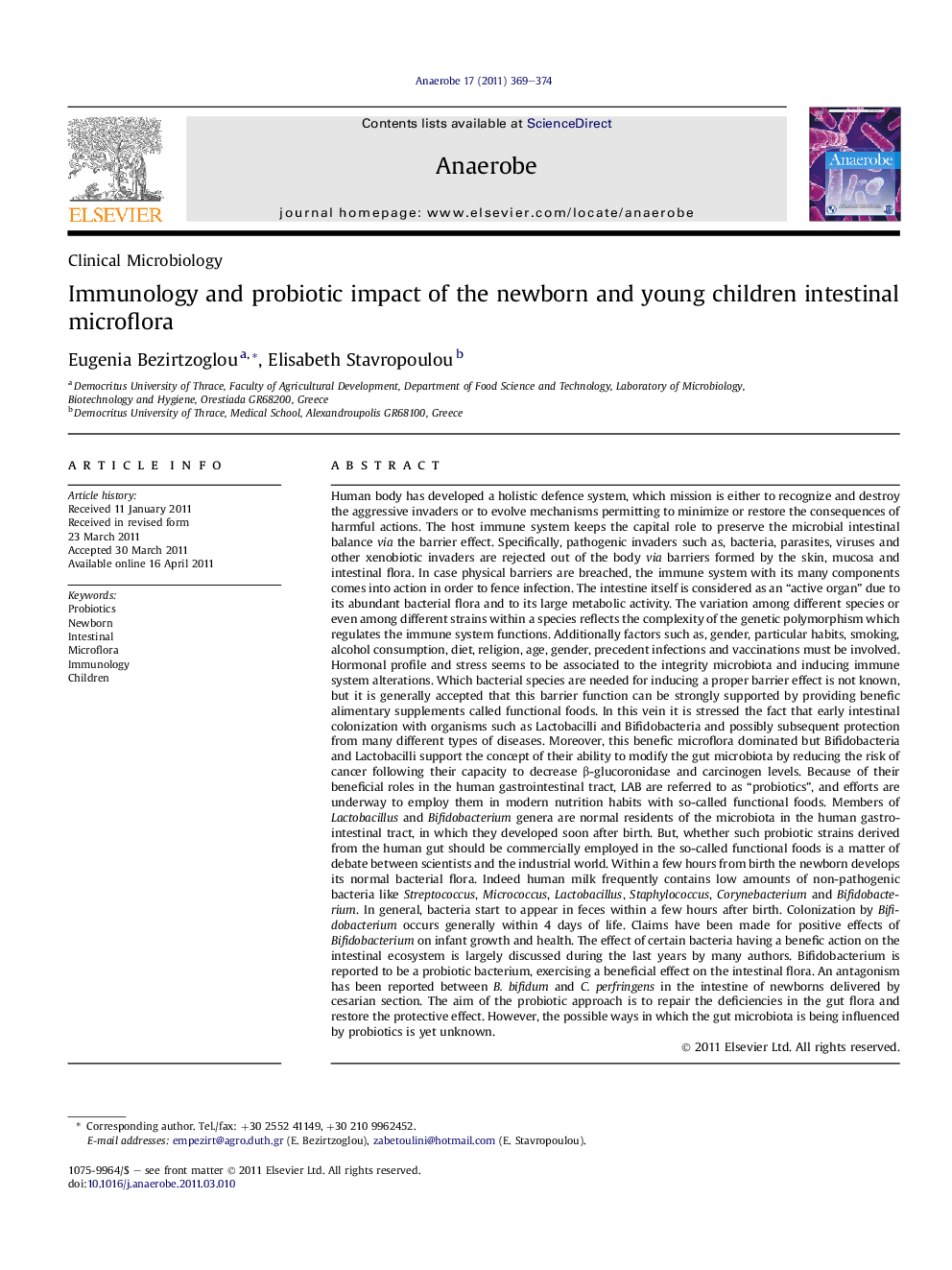| کد مقاله | کد نشریه | سال انتشار | مقاله انگلیسی | نسخه تمام متن |
|---|---|---|---|---|
| 3395438 | 1221687 | 2011 | 6 صفحه PDF | دانلود رایگان |

Human body has developed a holistic defence system, which mission is either to recognize and destroy the aggressive invaders or to evolve mechanisms permitting to minimize or restore the consequences of harmful actions. The host immune system keeps the capital role to preserve the microbial intestinal balance via the barrier effect. Specifically, pathogenic invaders such as, bacteria, parasites, viruses and other xenobiotic invaders are rejected out of the body via barriers formed by the skin, mucosa and intestinal flora. In case physical barriers are breached, the immune system with its many components comes into action in order to fence infection. The intestine itself is considered as an “active organ” due to its abundant bacterial flora and to its large metabolic activity. The variation among different species or even among different strains within a species reflects the complexity of the genetic polymorphism which regulates the immune system functions. Additionally factors such as, gender, particular habits, smoking, alcohol consumption, diet, religion, age, gender, precedent infections and vaccinations must be involved. Hormonal profile and stress seems to be associated to the integrity microbiota and inducing immune system alterations. Which bacterial species are needed for inducing a proper barrier effect is not known, but it is generally accepted that this barrier function can be strongly supported by providing benefic alimentary supplements called functional foods. In this vein it is stressed the fact that early intestinal colonization with organisms such as Lactobacilli and Bifidobacteria and possibly subsequent protection from many different types of diseases. Moreover, this benefic microflora dominated but Bifidobacteria and Lactobacilli support the concept of their ability to modify the gut microbiota by reducing the risk of cancer following their capacity to decrease β-glucoronidase and carcinogen levels. Because of their beneficial roles in the human gastrointestinal tract, LAB are referred to as “probiotics”, and efforts are underway to employ them in modern nutrition habits with so-called functional foods. Members of Lactobacillus and Bifidobacterium genera are normal residents of the microbiota in the human gastrointestinal tract, in which they developed soon after birth. But, whether such probiotic strains derived from the human gut should be commercially employed in the so-called functional foods is a matter of debate between scientists and the industrial world. Within a few hours from birth the newborn develops its normal bacterial flora. Indeed human milk frequently contains low amounts of non-pathogenic bacteria like Streptococcus, Micrococcus, Lactobacillus, Staphylococcus, Corynebacterium and Bifidobacterium. In general, bacteria start to appear in feces within a few hours after birth. Colonization by Bifidobacterium occurs generally within 4 days of life. Claims have been made for positive effects of Bifidobacterium on infant growth and health. The effect of certain bacteria having a benefic action on the intestinal ecosystem is largely discussed during the last years by many authors. Bifidobacterium is reported to be a probiotic bacterium, exercising a beneficial effect on the intestinal flora. An antagonism has been reported between B. bifidum and C. perfringens in the intestine of newborns delivered by cesarian section. The aim of the probiotic approach is to repair the deficiencies in the gut flora and restore the protective effect. However, the possible ways in which the gut microbiota is being influenced by probiotics is yet unknown.
Journal: Anaerobe - Volume 17, Issue 6, December 2011, Pages 369–374